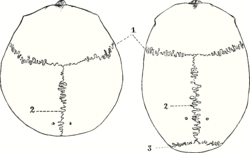|
Marie-Francois Xavier Bichat (1771 - 1802). French physician, surgeon, anatomist and physiologist, Marie-Francois Xavier Bichat was born in the village of Thoirette. His father was a physician, influencing his early instruction and vocation. In Lyon he studied anatomy and surgery. At 28 years of age Bichat was appointed physician to the Hôtel (Hospital) Dieu. His life was influenced by his mentor, Pierre-Joseph Dassault (1738 - 1795). Upon his mentor's death Bichat took upon him to continue and finish his work, while supporting his mentor's family.
Bichat is know for the concept of the body composed of distinct tissues, which he originally called "membranes". Without the aid of the microscope Bichat described 21 different tissues and is considered the founder of the science of histology. His name is preserved in many eponymic structures such as Bichat’s fossa (pterygopalatine fossa), Bichat’s buccal fat pad, Bichat’s foramen (cistern of the vena magna of Galen), Bichat’s ligament (lower fasciculus of the posterior sacroiliac ligament), and Bichat’s tunica intima (tunica intima vasorum).
Xavier Bichat also contributed to a newer description of the humoral physiological theory, later becoming the basis of hematology. He was also interested in the description of life and death, proposing the existence of an "organic life" and an "animal life". An interesting note is that Bichat died because of an infection he acquired while dissecting a cadaver. Remember that at the time, no embalming was used!
Today Bichat's name is almost forgotten, although in some countries the buccal fat pad is still called "Bichat's fat pad" In many Spanish-speaking countries this structure is referred to as "la bola grasa de Bichat", and many still refer to the removal of this fat pad as "Bichectomy". For an image of the before and after of the procedure, click here.
Sources:
1. "Marie-Fran?ois Xavier Bichat (1771-1802) and his contributions to the foundations of pathological anatomy and modern medicine" Shoja M.M., Tubbs R.S., Loukas M., Shokouhi G., Ardalan M.R.(2008) Annals of Anatomy, 190(5),413-420
2. "Physiological Researches on Life and Death" Bichat, Marie-Francois Xavier, 1827. Translated from French by F. Gold. Richardson and Lord, Boston.
3. "A Historical Perspective: Infection from Cadaveric Dissection from the 18th to the 20th Centuries" Shoja, MM et al. Clin Anat (2013) 26:154-160
|

Original image courtesy of
Images from the History of Medicine
|






